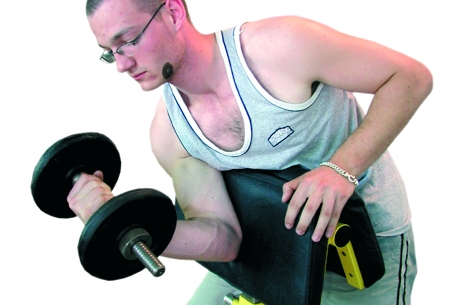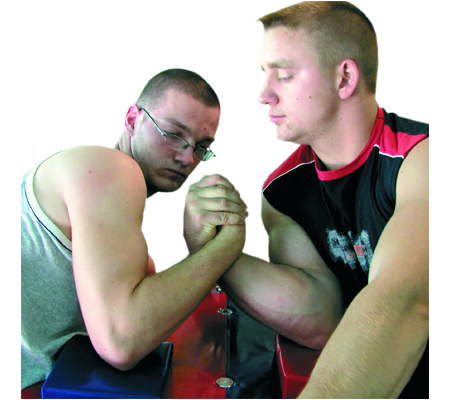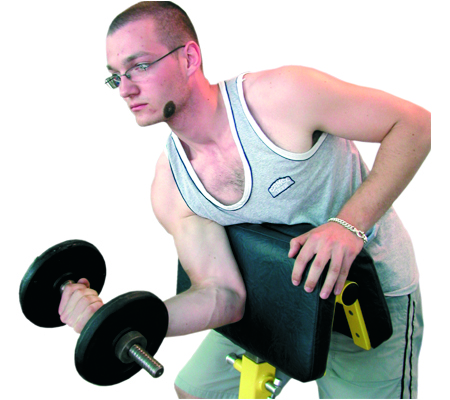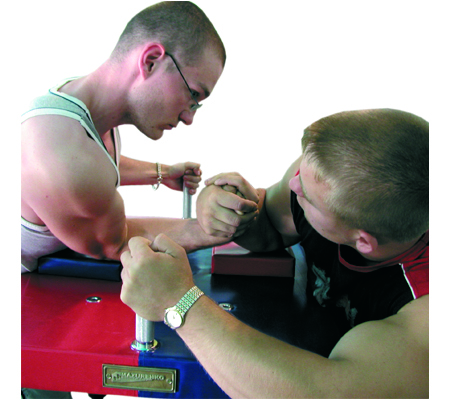
How to train biceps and in how many stages.
Biceps play a huge role in a fight. One shouldn’t even approach the table without it. It needs to be trained twice a week, with special attention to isometrics. It’s them that strengthen the tendons and make biceps stronger. Statics should be accompanied by a good warmup, 1-2 sets with full range of movement (15 – 18 reps).
Biceps training can be divided into three stages: increasing strength, training endurance and tournament prep (technique, reaction, speed).
Taking this into account, you should plan your workouts accordingly:

Phase one – increasing strength – multiple sets with small number of reps. An example scheme would be: bicep curls with dumbbell – two sets to warm up tendons, let's say two sets, 15 reps each. At third set, increase weights to be able to perform only 10 – 11 reps. Keep working until you reach: 4th set: 8 – 9 reps, 5th set: 6-7 reps, 6th set: 4-5 reps, 7th set: 2-3 reps, 8th set: static hold of 5-10 seconds (right angle between arm and forearm).
Another very important element in your training is sparring. In strength increasing periods it's not recommended to fight at the table more than once a week. With less experienced fighters, strength increasing periods should start 4-5 months before a tournament. With more experienced fighters – 2-3 months. The more experienced fighter should focus more on isometrics. Training three times a week is enough even for a professional.
 Phase two is all about transforming strength into stamina. During any competition a fighter might participate in 7 – 10 bouts and cannot perform properly without stamina and special preparation. An arm becomes pumped out quickly, it goes numb and almost useless. Here's a tip how to avoid that. Phase two begins about 1,5 – 2 months before a tournament for the less experienced, and 1 – 1,5 months for the more experienced. In this phase, the number of reps is slightly smaller, but isometrics are held longer and more often. An example would be: 1-2 sets of warmup – 15-18 reps. Starting from set three we increase the weights to be able to perform only 10 – 11 reps. Then proceed accordingly: 4th set: 8-9 reps, 5th set increasing weights to perform hold for 20 – 25 seconds, 6th set increasing weights, hold for 15 – 20 seconds, 7th set increasing weights, hold for 10 – 15 seconds. This scheme applies to every exercise in this phase. Notice that holds are perfomed at certain angles. Sparrings should be performed twice a week. Start training with table work and after 25 – 30 minutes proceed to basic trainign with weights and isometrics. When doing table work, train both your strong sides and weaknesses.
Phase two is all about transforming strength into stamina. During any competition a fighter might participate in 7 – 10 bouts and cannot perform properly without stamina and special preparation. An arm becomes pumped out quickly, it goes numb and almost useless. Here's a tip how to avoid that. Phase two begins about 1,5 – 2 months before a tournament for the less experienced, and 1 – 1,5 months for the more experienced. In this phase, the number of reps is slightly smaller, but isometrics are held longer and more often. An example would be: 1-2 sets of warmup – 15-18 reps. Starting from set three we increase the weights to be able to perform only 10 – 11 reps. Then proceed accordingly: 4th set: 8-9 reps, 5th set increasing weights to perform hold for 20 – 25 seconds, 6th set increasing weights, hold for 15 – 20 seconds, 7th set increasing weights, hold for 10 – 15 seconds. This scheme applies to every exercise in this phase. Notice that holds are perfomed at certain angles. Sparrings should be performed twice a week. Start training with table work and after 25 – 30 minutes proceed to basic trainign with weights and isometrics. When doing table work, train both your strong sides and weaknesses.

Phase three is very complex and includes high risk of injury, but when approached wisely, it ahould go well. The most important part of this phase is table work with partner. Each technical exercise should be performed after Ready Go. We work on our attack, defence and counters. Not to worry anyone, but an experienced coach or training partner would be very useful at this stage. Lack of experience and knowledge at this point may result in injuries and having to take a break from training.
Weights training should be performed 1 – 2 a week, and focused on your weak angles, Experienced fighters may train 4-5 times a week, but everything depends on experience, age and regeneration periods.
A training scheme for this period would be:
1 – 2 sets of 15 – 18 reps, 3rd set 10 reps, 4th set 8 reps, 5th set 6 reps, 6th set performed with rubber band for speed (weights not recommended, as they might cause tendon injuries).


